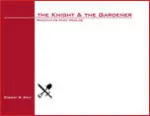112
Gardeners believe mysticism aids one’s communion with God. Most Gardeners do not need an elaborate faith superstructure to believe in God or get to heaven—merely a few spiritual and theological “seeds” to grow on. They are not anti-superstructure; they just understand superstructures as devices or tools rather than absolute truths.
Gardeners understand that the spiritual truth of a situation can be larger than its literal truth. For example, many of us have seen a teenager ask a combat veteran what war is like, and the veteran finding himself utterly unable to express the truth of what war is. The veteran often simply says nothing. Spirituality can be like that, too.
Novelist Tim O’Brien tried to express the veteran’s dilemma in his short story “How to Tell a True War Story.” In the story he tells the tale of two buddies in his platoon in Vietnam—Curt Lemon and “Rat” Kiley. One day on patrol, Curt Lemon stepped on a land mine and was blasted into a tree. He was killed instantly. The next day the platoon entered a village, and in the middle of the village there was a baby water buffalo tied to a stake. Rat Kiley walked over to the baby water buffalo, stared at it for a moment, then shot its ears off, then its nose, and tail. Then he shot out its knees and it fell to the ground in agony. He continued to pick off flesh with each shot, but the beast would not die. So Rat and several other soldiers threw it down the village well where it finally passed away.
Often, when Tim O’Brien tells this story at author signings, an elderly lady will come up to him afterwards and tell him what a sad story it was, how badly she felt for the baby water buffalo, and what an awful war story it was. O’Brien says he never has the heart to tell these ladies that it’s not a war story; it’s a love story. It’s the story of how Rat Kiley loved Curt Lemon so much that he could not handle it when Curt died. The loss was so great that Rat behaved horrifically.
In reality, O’Brien writes, Rat did not maim a baby water buffalo—there was no water buffalo. Rat was simply very quiet for a few days. O’Brien knew, though, that writing what literally happened would not convey the depth of Rat’s mourning, so O’Brien created the baby water buffalo story to express the truth of what Rat was going through. In essence, O’Brien created a fiction—a literal untruth—to express a spiritual truth.
Gardeners do not believe something has to be literally true for it to be spiritually true. This means that Gardeners do not become too attached to particular faith superstructures—they know that God resides beyond them all, and that when one light bulb (superstructure) blows out, God will shine through via another one. Because of this, Gardeners tend to be more comfortable with uncertainty and ambiguity when it comes to faith—they know it keeps them spiritually advancing rather than remaining merely spiritually advanced.
Frederick Buechner once wrote that the most useless faith-related phrase today is “There is God in the highest,” asserting that “There is mystery and meaning in the deepest” is better for beginning conversations about faith. He meant that rather than presenting a faith superstructure for people to accept or reject, Christians should invoke in others a sense of mystery, of mysticism, because the subsequent journey leads to communion with the divine.
Gardeners do not root their faith in beliefs about God, or a perfect superstructure—or even in a mere feeling about God—but rather in an unspeakable sense of God.


